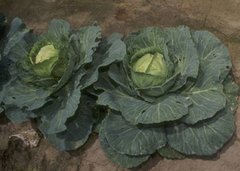| Cabbage | ||||||||||||||
|---|---|---|---|---|---|---|---|---|---|---|---|---|---|---|
Cabbage plants | ||||||||||||||
| Scientific classification | ||||||||||||||
| ||||||||||||||
| Cultivar Group | ||||||||||||||
| Brassica oleracea Capitata Group |
The cabbage (Brassica oleracea Capitata Group) is an edible plant of the Family Brassicaceae (or Cruciferae). It is herbaceous, biennial, and a dicotyledonous flowering plant with leaves forming a characteristic compact head. Surprisingly, cabbage, broccoli (Italica Group), cauliflower (Botrytis Group), collard greens (Acephala Group), kohlrabi (Gongylodes Group), brussels sprouts (Gemmifera Group), Chinese kale or Chinese broccoli (Alboglabra Group), broccolini (Italica x Alboglabra Group), and broccoflower (Italica x Botrytis Group) are all cultivars of the same plant species, Brassica oleracea.
The cabbage head was bred into the species from the leafy wild plant, found in the Mediterranean region around 100 CE. The English name derives from the French caboche (head). Varieties include Red cabbage, Savoy cabbage, and Chinese cabbage.
Cabbages are commonly used both cooked and as a salad vegetable. They keep well and were thus a common winter vegetable before refrigeration and long-distance shipping of produce. Sauerkraut is a fermented cabbage often used as a condiment or side dish.
The caterpillars of some butterflies in the family Pieridae (the "whites") feed on brassicas and can be serious pests.
The juice of the red cabbage can be used as a pH indicator[1] (http://chemistry.about.com/library/weekly/aa012803a.htm).
Culture
Broadly speaking, two groups of varieties are available: early and late. The early varieties mature in about 50 days. They produce small heads which do not keep well and are intended for consumption while fresh. The late cabbage matures in about 80 days, and produces a larger head.
Cabbage can be started indoors or sowed directly. Like all brassicae, cabbage is a cool season crop, so early and late plantings do better than those maturing in the heat of the summer.
Control of insect pests is important, particularly in commercial production where appearance is important. Sevin and malathion are both listed for use on cabbage.
Krautman is the most common variety for commercial production of sauerkraut.
Several varieties of Brassica oleracea, including kale, Brussels sprouts, Savoy, and Chinese kale
See also
- Chinese cabbage (Brassica campestris)
- Kerguelen cabbage (Pringlea antiscorbutica)

